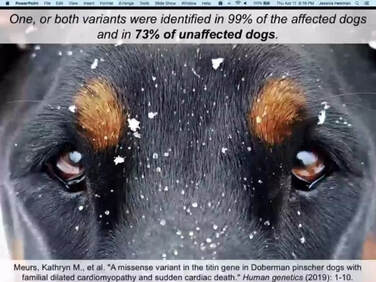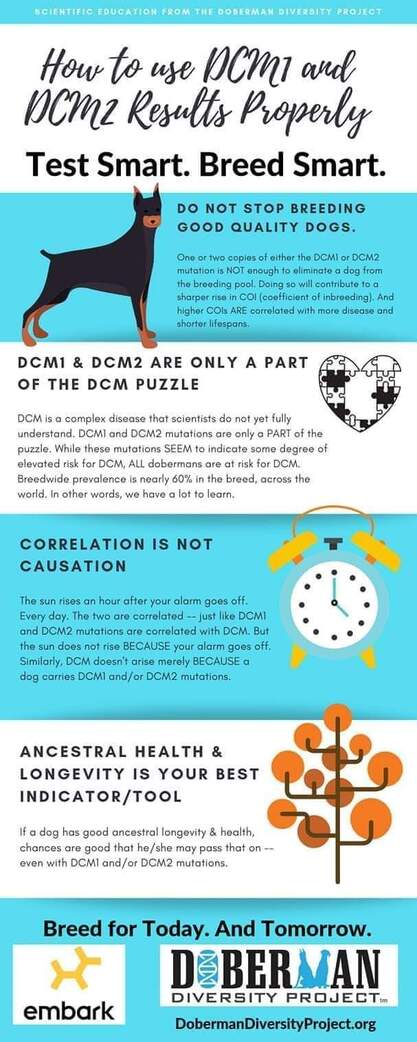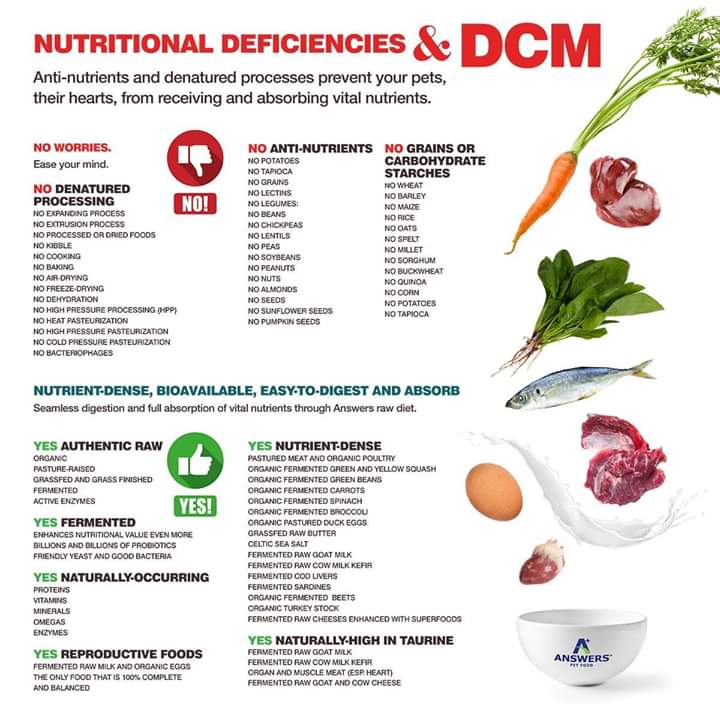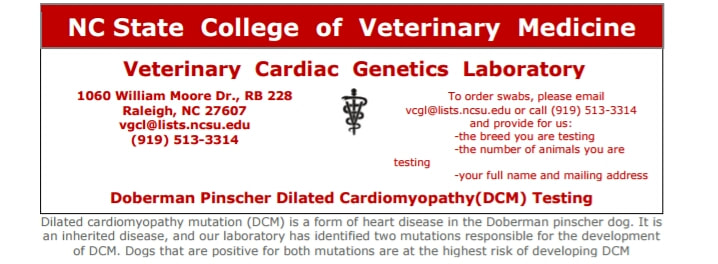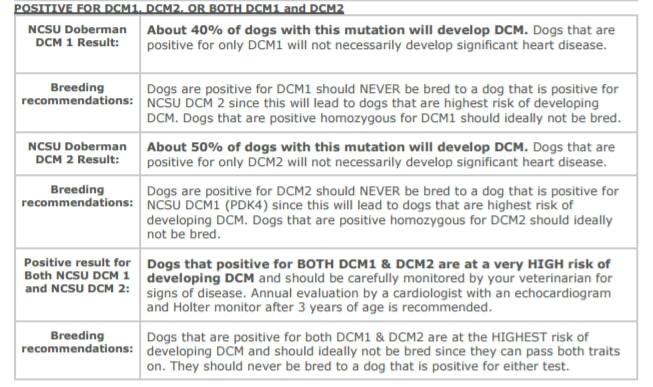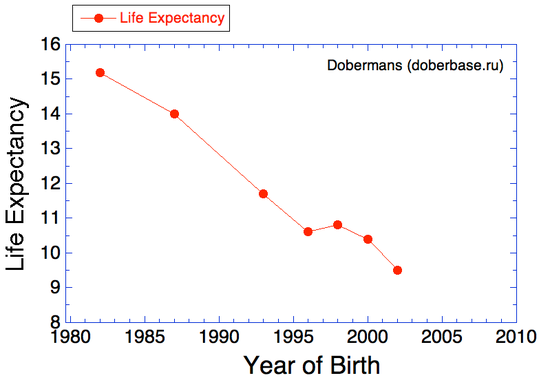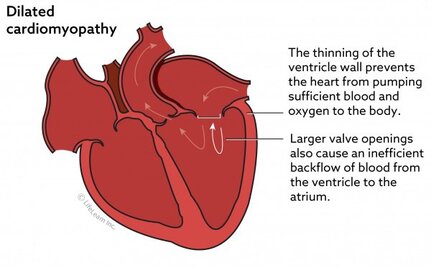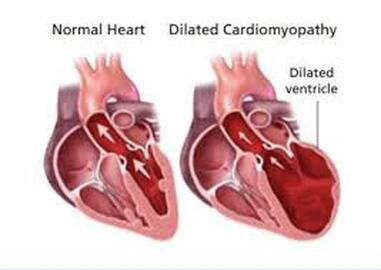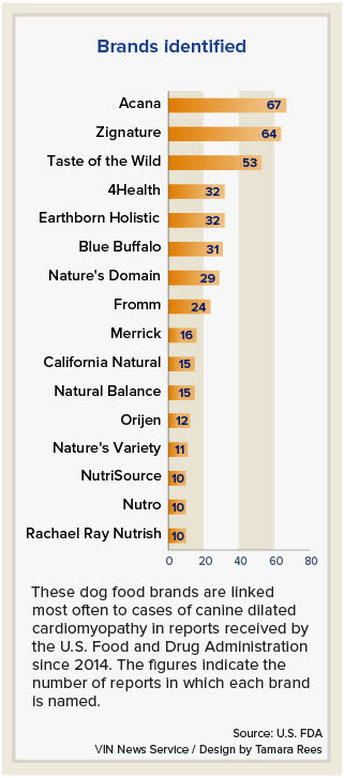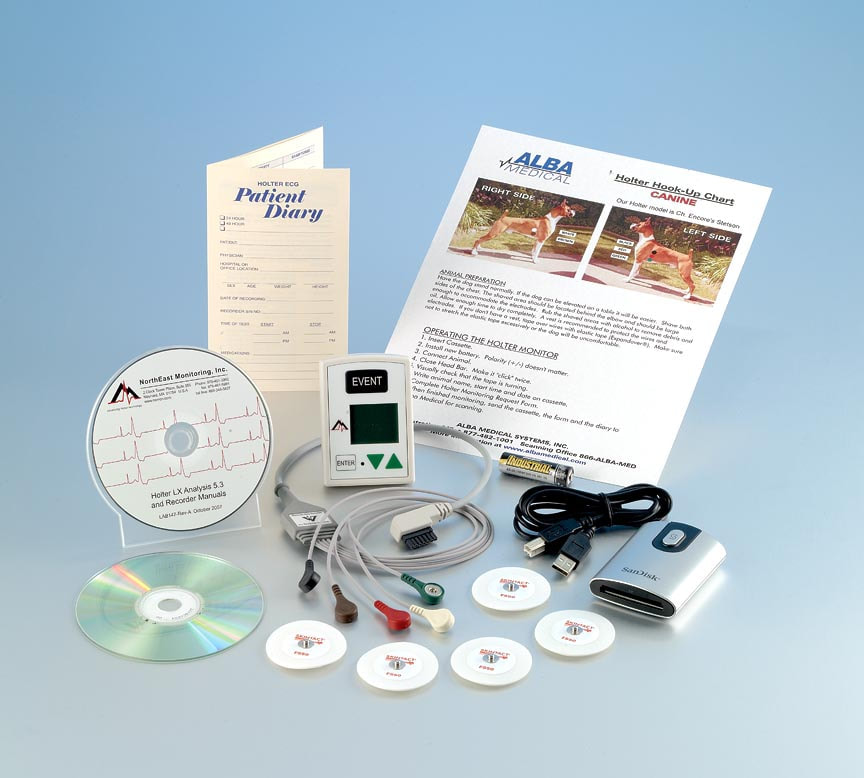The Rise of DCM
Prevalence of DCM in Doberman Study: https://pubmed.ncbi.nlm.nih.gov/20202106/
Doberman and Genetics
DCM Myths
|
Doberman Diversity Crisis, Diet, and DCM as an Autoimmune Disease
|
DCM isn't just genetic related, there is a diet component too. There is a strong link between DCM and diet in several breeds. Vets noticed a sharp increase in DCM cases in breeds not typically prone to DCM. Many pet owners went to the FDA and complained about thier pet's health, which promptly the FDA to look into the matter. While research into the exact cause is still in process one thing is certain; fad diets are bad for our dogs. Fad diets include grain-free, exotic meats, meat only diets, BARF, raw diets and vegan (please, don't feed your omnivorous pet a plant only diet; it will kill him). Avoid trending diets and cures (such as tea tree oil, coconut oil, garlic - which is TOXIC to dogs, and so on). The evidence is solid; fad diets are hurting our pets. But what else may be? Many external factor have an effect on the disease. DCM is complex and hard to predict.
Doberman are one of the most inbred of all the dog world. All Doberman share the same 10 halotypes. That means they are all so closely related to one another it is as if breeding family members together! The average inbreeding ratio is 43%! There is not much diversity left to support healthy dogs and sustain a stable population for long. Lack of diversity gives rise to genetic mutations being passed down more frequently (homozygosity). The smaller gene pool the more the traits are shared.
|
Doberman Genetic Crisis - https://www.instituteofcaninebiology.org/blog/an-update-on-the-genetic-status-of-the-doberman-pinscher
https://www.instituteofcaninebiology.org/blog/are-we-watching-the-extinction-of-a-breed-or-why-are-we-focused-on-consequence-instead-of-cause
Doberman Longevivity Study - https://www.veterinarypracticenews.com/uf-announces-lifetime-study-on-fatal-heart-disease-in-doberman-pinschers/
Doberman Diversity Project (open to select populations) - https://www.dobermandiversityproject.org/
Grain Free Diet/Nutritional DCM - https://news.vin.com/vinnews.aspx?articleId=52712
https://www.vin.com/apputil/content/defaultadv1.aspx?meta=&pId=11149&id=3846592
Rates of DCM - https://www.ufaw.org.uk/dogs/doberman-pinscher-dilated-cardiomyopathy
Predictors of DCM - https://www.ncbi.nlm.nih.gov/pmc/articles/PMC4913570/
DCM Related Autoantibodies - https://journals.plos.org/plosone/article?id=10.1371/journal.pone.0214263
Why What was Recommended isn't Working
"Recommended Testing Protocol for Cardiac Disease. Annual echocardiograms (an ultrasound of the heart), together with 24 hour Holter Monitoring, provides a snapshot of a dog's current heart health at that moment in time. Your vet can also perform a simple blood test that measures the concentration of NTproBNP in your dog's blood and is a good indicator of heart health. It is important to understand that test results can be normal one year and a dog can show signs of DCM the very next year. This is why breeders must perform ANNUAL heart screening. Two DNA genetic tests are available; they identify two mutations (PDK4) and DCM2) that are thought to be associated with DCM. The tests involves a simple cheek swab and don't necessitate a veterinary visit."
https://www.dobermandiversityproject.org/diseases.html
DCM Genes are IMPORTANT
|
"Important note about the TTN mutation (also known as DCM2): The vast majority of research exploring the genetics of DCM has been performed on purebred American Dobermans, a high risk population for DCM. Even in the Doberman, DCM2 is incompletely penetrant, meaning that while having one or two copies of this mutation is thought to confer some increased risk of developing DCM, it is by no means predictive of disease. DCM is a highly complex disease that is modulated by many genetic factors, most unknown. In addition, Embark and others have identified this mutation in multiple breeds, including breeds where DCM is not a common disease. The impact of this mutation in these breeds is unknown: Embark hopes to change this." - Embark on TTN/DCM2
Another tidbit to note; PDK4 (aka DCM1) is not associated with DCM in the European population. It is important to know the pedigree; if there are any non-Euro dogs in the pedigree PDK4 may be associated with DCM in your dog! There are other DCM variants that do have significance in risk of disease development. - https://www.google.com/search?q=pdk4+doberman+european&oq=PDK4&aqs=chrome.1.69i57j69i59j69i61.7369j0j9&sourceid=chrome&ie=UTF-8
58% of European Dobermans develop DCM by age 8 ( Wess et al (2010a)). - https://www.ufaw.org.uk/dogs/doberman-pinscher-dilated-cardiomyopathy (a note on this article; elimination of all carriers even affected dogs would eliminate of 70% of Doberman. This is not realistic nor sustainable for the breeds future. There is not enough evidence supporting a drastic elimination of the genes as gene free dogs still develop DCM.) Population diversity is crucial to reducing DCM and saving the breed.
|
- https://pubmed.ncbi.nlm.nih.gov/27027709/, additional articles: https://avmajournals.avma.org/doi/10.2460/ajvr.77.2.156,
https://www.ncbi.nlm.nih.gov/pmc/articles/PMC5745584/
The science behind DCM genetics is solid and proven. It is real, tangible and reliable. There is validity to the genes significance in indirect disease predisposition. Though the genes are a small portion of DCM risk they are still very important! Any piece of the puzzle is a crucial one. It is important to note that, while the DCM genes play a role in the indirect predisposition to the disease, they are not diagnostic nor preventative. In December 2011 the Doberman tested through Vetnostic as clear/two normal DCM1(PDK4) genes 15% had early clinical symptoms of DCM. DCM is complex and has many factors. The genes are an important step in mapping out the cause of DCM but shouldn't be used as definitive testing.
A note on Cardiac Regenerative Therapies aka Gene Therapy: Gene therapy is a promising treatment option and could change the way DCM is managed. It's been shown to restore cardiac function and improve quality of life. "Gene transfer strategies to reduce calcium cycling abnormalities improve heart function in animal models as well as in human clinical trials. In this study, Dr. Sleeper will conduct a placebo-controlled, double blinded study to evaluate gene delivery approaches for treatment of Doberman Pinschers affected with DCM and CHF. If results show that the gene delivery slows progression of heart failure in Dobermans with DCM, the results will have significant ramifications for all dogs with heart disease, as calcium handling proteins are abnormally expressed in dogs with heart disease of varying causes." - https://www.akcchf.org/research/research-portfolio/1760.html Dr. Meg Sleeper is the Cardiologist performing this study. https://research.vetmed.ufl.edu/clinical-trials/small-animal/dcm-in-dobermans/
"We have successfully used gene therapy with AAV2tm-cPDK4 to transfect skin fibroblasts of Dobermans carrying the genetic mutation to assess changes in the OCR. Preliminary results of this experiment have shown a trending in increase in OCR." - Cardiac_Regenerative_Therapy_for_Dilated_Cardiomyopathy_in_Doberman_Pinchers_with_PDK4_gene_mutation
| dcm_gene_therapy_-_keystonesymposiumluizbolferfinal.pdf |
Methods to Reduce DCM Occurrence
- Elimination Method - Stop breeding dogs with multiple DCM genes or who have positive echos/holter tests.
- Avoidance Method - Avoid lines and familial groups who develop or are related to a dog that develops DCM.
- Selective Breeding - Breed only certain dogs who meet a strict genetic and physical standard.
- Outcross Genepools - Staying within the breed, bring in unrelated lines and breed together
- Outcross Other Breeds - Select one or multiple breeds to crossbreed into the Doberman and selectively breed the desirable dogs back to purebred Doberman, continuing to breed back to more purebred Doberman.
- Low COI Method - Selectively breed dogs with testes low COI (Coefficient of Inbreeding) to produce low COI litters
Outcrossing? Is it a Viable Option?
Much like the LUA program that outcrossed to correct and reduce the rate of painful and often fatal bladder stones in the Dalmatian, an outcross program may help save the Doberman breed and allow for fresh, untapped lines to be worked into the diversity pool. Diversity can't be added without actually adding to the gene pool. You can't just create new diversity from the diversity we have now.
Let's speculate an outcross program is started and approved by the DPCA. How should it be done? I personally feel we should avoid breeds with VWD, PRA, and cardiac issues. Selecting the best dogs genetically as well as health-wise is crucial. Second, you would breed to look at the dog physically, matching with breeds similar in build to the Doberman. Thirdly, you want to consider the temperament and working ability. You don't just want a dog to look like a Doberman, you want it to be a Doberman. Once you have established a solid base of dogs to cross between, you then start the tedious process of selecting which dogs fit the Doberman standard and your health/program aim and keep them back. You continue to selectively breed until you have worked back up to purebred Doberman (genetically testing as 98% and higher). Temperament testing and working ability can be assessed by professional trainers.
I firmly believe the key to saving the Doberman and preserving the breed is to create more diversity. How that is to be best done is the million dollar question!
"As far as we are aware, there are currently no formal breeding schemes operating which aim to reduce or eliminate this common condition from the Doberman pinscher breed. A genetic test would be very valuable as this would enable the detection and removal of affected individuals from the breeding pool. However, because the condition is so common in Dobermans, there is concern that removal of all affected individuals from the breeding pool might cause excessive restriction in the choice of Dobermans to breed from, and hence a reduction in the size of the breed’s gene pool with the risk that other genetic defects may inadvertently increase in frequency. Such problems could be avoided by out-breeding with dogs of other breeds." - https://www.ufaw.org.uk/dogs/doberman-pinscher-dilated-cardiomyopathy
Keeping Purebreds Purebred
What is the Best Way to Screen for DCM?
- The first testing option is blood markers: NT-pro BNP, Troponin 1, N-Terminal pro-B-type Natriuretic Peptide (cardiac panel). This method is often the most affordable one and easiest to access as any veterinarian can order it.
- The second (and very accurate) screening is a 24 hr holter. Holter testing is extremely reliable, and is the most affordable option if you purchase your own unit. Holter alone can be enough to diagnose DCM regardless of clinical symptoms.
- Another method of screening is chest xray: assess the size of the heart and any fluid in the chest/around the heart or lungs. "Radiology plays an important part in the diagnosis and management of cardiac disease. It allows assessment of the pulmonary vasculature and lungs which is not possible with echocardiology" https://vetspecialists.co.uk/fact-sheets-post/dilated-cardiomyopathy-dcm-fact-sheet/, https://www.vetstream.com/treat/canis/freeform/radiology-cardiac-examination
- The next screening method is echocardiogram/auscultation. It is more expensive than a holter test but is reliable in detecting DCM and changes in heart size/function. "Results suggest that 12-lead A-ECG might improve diagnostic value of short-duration ECG in earlier detection of canine DCM as five selected ECG parameters can with reasonable accuracy identify occult DCM in Doberman Pinschers." https://ntrs.nasa.gov/citations/20110011044
- Another combo screening method is 24 holter and NT-pro BNP done annually. "Combination of NT-proBNP and Holter to detect ODCM yielded sensitivity of 94.5%,specificity of 87.8%, and accuracy of 91.0%." https://onlinelibrary.wiley.com/doi/full/10.1111/j.1939-1676.2012.1000.x
- The current most popular combo screening method is 24-hr holter and annual or bi-annual echo/auscultations. These methods take a look at the shape and function of the heart, but not of the vascular system (which an Xray does).
- The last combo screening method is a 5 minute echo/auscultation, a 24-hr holter, and NT-pro BNP done annually. The European Society of Veterinary Cardiology recommends "Screening for occult DCM in Dobermans should start at three years of age and use both Holter monitoring and echocardiography. ... The guidelines also provide recommendations concerning ancillary tests, that are not included in the standard screening protocol, but which may have some utility when recommended tests are not available or financially untenable on an annual basis. These tests include assay of cardiac biomarkers (Troponin I and N-Terminal pro-B-type Natriuretic Peptide) as well as a 5-min resting electrocardiogram (ECG)."
Testing for DCM: https://www.vin.com/apputil/content/defaultadv1.aspx?id=3860877&pid=11242
How We Manage Our Breeding Program and DCM
The Real Question: Do I Holter/Echo?
Holter: In 2020 I purchased our first holter (the DR200) unit to for use in my program. My holter is NOT for rent/lease. I do annual holters.
Echo/Auscultation: I do annual-biannual echos and auscultations examining for congenital defects as well as changes in the heart.
Evidence suggests lack of genetic diversity may cause DCM to behave more as an autoimmune disease (β1-AAB associated autoimmunity). In Doberman the PDK4 gene has been shown to have metabolic change which remodels the heart, eventually leading to heart failure. Holter and echos are diagnostic tools used to identify DCM and cardiac abnormalities. It can not prevent DCM, just diagnose it. The last 30 years of holter and echo testing has failed to reduce the rate of DCM, even with the Holter project and DCM education. DCM effects over 50+% of the breed. With half of all Doberman developing DCM in their lifetime testing has failed to be a reliable method in eliminating DCM. Knowing is valuable, but it won't stop DCM. DCM is much more complex than originally believed. Again, I redirect back to the topic of diversity. I firmly believe lack of diversity has given way to the rise of DCM.
| 20110011044.pdf |
What to Take From This
When looking for a Doberman keep in mind NO line is free from the DCM risk. It is the shadow that haunts the breed. Maybe in time research will find a way to eliminate it. Right now, many scientists are leaning towards low COI as the key to reduce and potentially eliminate DCM one day. Good breeders look beyond the appearance and titles. They look past the health testing. Good breeders look at the future; they look at how to get today's dogs to be tomorrow's foundation. No line is DCM free. A good breeder should explain the breed's disposition to DCM and should be breeding for diversity and for longevity. Hopefully, as good breeders breed for the future DCM will be just a vague memory.
What is DCM1 ?
DCM is the most common acquired heart disease of adult dogs. The heart has two heavily muscled ventricles that pump blood away from the heart. This disease causes progressive weakening of the ventricles by reducing the muscle mass, which causes the ventricles to dilate. Dilated ventricles do not contract and circulate oxygenated blood well, which eventually leads to heart failure.
About DCM1
When signs & symptoms develop in affected dogs
This disease can rarely be seen in puppies and young adults. It is typically seen in middle aged to older dogs.
Signs & symptoms
In the early stages of DCM, you will likely not notice any changes in your dog. DCM typically presents at the end stages of the disease, when the heart is failing. Signs include weakness, cold toes and ears, blue-grey gums and tongue, and respiratory distress. If you see these signs, take your dog immediately to an emergency veterinarian!
How vets diagnose this condition
The earlier a diagnosis can be reached, the better the outcome. If you are concerned about your dog’s heart, discuss it with your veterinarian who can run basic preliminary tests. They may recommend a visit to a veterinary cardiologist for a complete evaluation, including an ultrasound of the heart (echocardiogram).
How this condition is treated
Treatment is completely dependent on how advanced the disease is at the time of diagnosis. It can range from monitoring the patient periodically to intensive hospitalization at specialty veterinary practices.
Actions to take if your dog is affected
- The cause of this disease is multifactorial and not completely understood. Genetics, nutrition, infections and environmental exposures can all play a role in the development of DCM. In fact, DCM has recently been featured extensively in the news due to suspected nutritional deficiencies in some grain free diets.
- Annual echocardiograms by a board certified cardiologist and annual Holter monitoring are the best ways to diagnose DCM early.
What is DCM2 ?
DCM is the most common acquired heart disease of adult dogs. The heart has two heavily muscled ventricles that pump blood away from the heart. This disease causes progressive weakening of the ventricles by reducing the muscle mass, which causes the ventricles to dilate. Dilated ventricles do not contract and circulate oxygenated blood well, which eventually leads to heart failure.
About DCM2
When signs & symptoms develop in affected dogs
This disease can rarely be seen in puppies and young adults. It is typically seen in middle aged to older dogs.
Signs & symptoms
In the early stages of DCM, you will likely not notice any changes in your dog. DCM typically presents at the end stages of the disease, when the heart is failing. Signs include weakness, cold toes and ears, blue-grey gums and tongue, and respiratory distress. If you see these signs, take your dog immediately to an emergency veterinarian!
How vets diagnose this condition
The earlier a diagnosis can be reached, the better the outcome. If you are concerned about your dog’s heart, discuss it with your veterinarian who can run basic preliminary tests. They may recommend a visit to a veterinary cardiologist for a complete evaluation, including an ultrasound of the heart (echocardiogram).
How this condition is treated
Treatment is completely dependent on how advanced the disease is at the time of diagnosis. It can range from monitoring the patient periodically to intensive hospitalization at specialty veterinary practices.
Actions to take if your dog is affected
- The cause of this disease is multifactorial and not completely understood. Genetics, nutrition, infections and environmental exposures can all play a role in the development of DCM. In fact, DCM has recently been featured extensively in the news due to suspected nutritional deficiencies in some grain free diets.
- Annual echocardiograms by a board certified cardiologist and annual Holter monitoring are the best ways to diagnose DCM early.
DCM Myths & Facts
Myth or Fact: Doberman have different hearts than other dog breeds.
MYTH: Doberman have the same structure and function of the heart as all other domestic canines. The myth started online via social media and has been gaining traction. There is no scientific basis to believe a Doberman has a "different" heart than other dogs. Many breeders use this myth to justify not doing cardiac exams or to dull the interest into the DCM genetic testing.
Myth or Fact: There are lines that don't have DCM.
MYTH: Every line has a disposition to DCM, regardless what the breeder tells you. The entire breed is prone to DCM due to the breed's origin and tight inbreeding/line-breeding.
Myth or Fact: The parents don't have DCM so their puppies won't get DCM.
MYTH: No dog is exempt from the potential to develop DCM. It has been known to skip generations. Remember 60+/-% of Doberman in the European study were effected with DCM by 8 years old.
Myth or Fact: An enlarged heart is not always DCM.
FACT: An enlarged heart is not always DCM, although, in most cases it is. There can be many ailments that can cause the heart to enlarge. Congestive heart failure is a condition where the heart enlarges but it is different than DCM.
Myth or Fact: Pet lines have less occurrences of DCM than show lines.
FACT: Research is showing dogs that come from what is commonly referred to as pet lines have less cases of DCM! That is great news for breeders looking to preserve the breed. It means pet lines offer invaluable genetic diversity to the gene pool crisis.
Myth or Fact: European Doberman don't get DCM.
MYTH: DCM is impartial when it comes to Dobermans. Many European Dobes are just as tightly line-bred, sometimes even more so, than American lines. All Doberman are subject to DCM regardless of pedigree, working, show or pet lines, and health testing.
Myth or Fact: DCM is always fatal and is incurable.
FACT: DCM is always fatal. When caught early enough the disease and arrhythmia can be managed with lifestyle changes, nutritional changes and medication. Unfortunately, there is no cure for DCM. Medication slows the progression and prolongs live. DCM can not be reversed, at least not permanently. A few reports of stem cell therapy has been promising with dogs going into remission for a short time.
Myth or Fact: Holter, echos, ecg and ultrasounds prevent DCM.
MYTH: There is no way to prevent DCM. Those are methods to diagnose DCM.
Myth or Fact: A white mark (on the foot/toes, chest, belly, face, neck, so on) means the dog is Z factored.
MYTH: The white markings have no relationship to the albino aka "white" Doberman. White hairs can be due to a scar or a naturally occurring white mark. The AKC standard allots for a white mark on the chest no more than 1/4 inch long and wide.
Myth or Fact: Not all white Doberman are Z factored.
MYTH: All the white Doberman descend from a single family line; Sheba (AKC registered name Padula’s Queen Sheba). Geneology testing further proves this, both by tracking pedigrees and by genetic testing the dogs. While there is the remotest chance an albino could be born to two traditional colored non-z parents, the chances it would be the same OCA2 as all Zs carry is beyond unlikely. If you see an albino Doberman being sold with non-z papers it is a scam (whether the breeder purposely paper-hung or was unaware, that dog is not a non-z).
Myth or Fact: Dilutes can't be shown and can't earn titles.
MYTH: While the European shows exclude dilutes as accepted colors, the AKC, UKC and IABCA are warming up to dilutes. Several dilutes, blues included, have finished championship titling. Here are a few dilute champions; INT CH, BOS Indy - Grand Seiger (blue/rust), CH. Brenda I'm A Fawn (fawn/rust), CH Echorum's Stormin Isabella (fawn/rust), MULTI CH Mach Barnie's Wicked Chopper Dreams (fawn/rust), CH Shal-mar's Confederate Soldier (fawn/rust).

